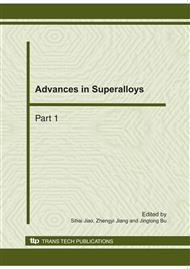p.1138
p.1142
p.1147
p.1154
p.1159
p.1163
p.1170
p.1174
p.1178
Influence of DepositionTemperature on Tensile Behavior and Fracture Characteristics of SiC Filament by Chemical Vapor Deposition
Abstract:
CH3SiCl3-H2-Ar system was adopted to prepare SiC Filament of high tensile strength by high-frequency induction during Chemical Vapor Deposition (CVD) method. Room-temperature tensile strength of SiC filament prepared under different temperature was test. Crystal structure, surface morphology and fracture character of SiC filament was analyzed with “X-ray diffractometer and scanning electron microscope. Influence of temperature to final tensile behavior of SiC filament was discussed synthetically. The result shows that tensile strength is very sensitive to temperature. From 1000°C to 1400°C, tensile strength increases and then decreases as temperature increases. At 1200°C, tensile strength reaches its max value, the reason ofwhich is composed of three parts. The first one is that the deposited product is β-SiC. The second one is that surface of SiC filament is smooth. The third one is that fracture surface shows ductile dimples fracture, brittle fracture and cleavage fracture patterns. 1200°Cis considered as one reasonable temperature in our laboratory to prepare SiC filament.
Info:
Periodical:
Pages:
1159-1162
Citation:
Online since:
October 2010
Authors:
Keywords:
Price:
Сopyright:
© 2011 Trans Tech Publications Ltd. All Rights Reserved
Share:
Citation:


